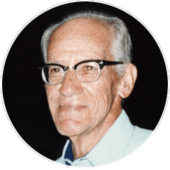
The Hanawalt Awards
Honoring J. Donald Hanawalt (1902-1987)
Congratulations to ICDD’s
2022 Hanawalt Award Recipient – Karena Chapman
Don Hanawalt joined The Dow Chemical Company as a Physicist in 1931 and became a Corporate Vice President by 1953. While Director of the Spectroscopy Laboratory in 1936, Don wrote his famous paper with co-author Sid Rinn on “The Identification of Crystalline Materials” which, along with a 1938 publication, are considered the foundation of powder X-ray diffraction as an analytical technique. Upon retirement in 1964, Don became Professor in the College of Engineering at the University of Michigan. He is also famous for his pioneering work in magnesium processing and alloy production. Don served as ICDD Chairman of the Board of Directors from 1976-1978.
Hanawalt Award
This award is named in honor of J. Donald Hanawalt, whose pioneering work in the 1930s led to the development of the PDF database structure and search/match procedures still in use today. The purpose of the award is to recognize distinguished, recent work in the field of powder diffraction. The award is presented every three years.
Selection Process
Awardees are chosen by the Hanawalt Award Selection Committee, which is comprised of past recipients. Work eligible for consideration must have been published within the past five years.
Award Presentation
The Hanawalt Award is presented at an appropriate powder diffraction/crystallographic meeting. The recipient is expected to submit an abstract and present a paper on the work being recognized. The award consists of a commemorative plaque, a gift of $2,500, and the recipient’s travel expenses to the meeting, in accordance with ICDD’s Travel Policy.
Submission Process
ICDD members may initiate nominations by sending an explanation of why a candidate should be considered for the award to The Corporate Secretary at corpsec@icdd.com. The deadline for initiating a nomination is 1 September. After a nomination is initiated, the Chairman of the Hanawalt Award Selection Committee Chairman will provide instructions for full nominations, including what to address in the nomination statement and seconds to the nomination. A deadline for completed nominations will be provided.
Chairman, Hanawalt Award Selection Committee
c/o The Corporate Secretary
International Centre for Diffraction Data
12 Campus Boulevard
Newtown Square Corporate Campus
Newtown Square, PA 19073-3273 USA
Fax: 610.325.9823
Email: awards@icdd.com
Ludo Frevel Scholarship
DXC Awards
SUBMISSION DEADLINE
The deadline for initiating a nomination is 1 September.
RECIPIENTS
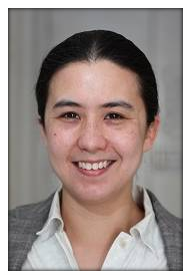
2022 Hanawalt Award – Karena Chapman – State University of New York at Stony Brook, New York
For her contributions in developing X-ray diffraction capabilities in the study of challenging materials problems in sustainable energy and environmental remediation.
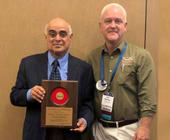
2019 Hanawalt Award – I. Cevdet Noyan
The 2019 Hanawalt Award presentation to I. Cevdet Noyan, Columbia University, New York, took place on August 7, at the Denver X-ray Conference, in Lombard, Illinois. This award honors Professor Noyan’s many relevant contributions to X-ray diffraction methods. Among the most recent contributions more specifically addressed to powder diffraction, the Hanawalt Award Selection Committee has considered the recent articles published by the Noyan group in the Journal of Applied Crystallography (48 (2015) 1212-1227; 50 (2017) 1307-1322), showing a rigorous physical modeling of the scattering processes from nanocrystalline materials.
Professor Noyan has been studying the mechanical response of crystalline materials over various length scales using diffraction for more than four decades. He was one of the first researchers to combine the theory of micromechanics with that of X-ray and neutron diffraction. Professor Noyan and his colleagues also study the theory of scattering, with particular emphasis on defining the information volumes from which diffraction data are measured, and quantification of the uncertainties associated with such data.
Professor Noyan received his Ph.D. in Materials Science & Engineering from Northwestern University in 1984. His early research work was at IBM, where he received two IBM Outstanding Technical Achievement Awards for research and development of computer and packaging structures, an IBM Research Division Award for research on diffusion barriers, and 11 IBM Invention Plateaus for filed patents. He is also coauthor of the monograph, Residual Stress: Measurement by Diffraction and Interpretation (Materials Research and Engineering).
Professor Noyan is a Fellow of the American Physical Society, and was a member of the Organizing Committee of the Denver X-ray Conference and Co-editor of the proceedings, Advances in X-ray Analysis until 2019. He has received the Blackall Machine Tool and Gage Award from the American Society of Mechanical Engineers in 2006; the Jenkins Award for lifetime achievement in the advancement of the use of X-rays in materials analysis in 2015; and the 2019 Hanawalt Award from the International Centre for Diffraction Data.
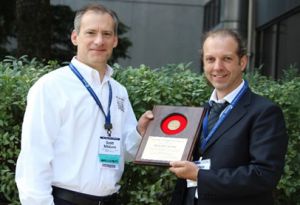
2016 Hanawalt Award – Matteo Leoni
Professor Leoni’s award and associated lecture were given at the 2016 Denver X-ray Conference (DXC) in Chicago, IL. His lecture, Detailed Microstructure Information from Powder Data: A Maze or Amazing?, was presented during the DXC Plenary Session.
Professor Leoni received his Master in Materials Engineering at the University of Trento in 1995, and Ph.D. in Materials Engineering at the University of Rome “Tor Vergata” in 1999. After a post-doc experience at the Max Planck Institute for Metals Research in Stuttgart, he returned to the University of Trento to continue his career first as post-doc, then as research professor, and now as Associate Professor in Materials Science and Engineering. Professor Leoni is the elected Chair of the Board of Directors of the ICDD and consultant for the Commission on Powder Diffraction of the International Union of Crystallography. He is currently working on the development, validation and application of novel methods for the quantitative analysis of structure and microstructure evolution of real materials (i.e. materials with defects) using powder diffraction and combined techniques. Of particular interest are those systems showing confined or lacking 3D periodicity (e.g. nano, 2D, layered, intercalated materials and, in general, materials with stacking defects).
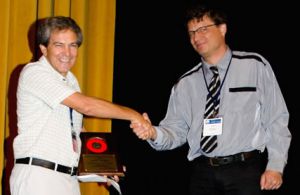
2016 Hanawalt Award – Dr. Paolo Scardi
Dr. Scardi’s award and accompanying lecture were given at the XTOP 2016 – 13th Biennial Conference on High-Resolution X-Ray Diffraction and Imaging, in Brno, Czech Republic. He concentrated on Whole Powder Pattern Modelling of Nanocrystalline and Plastically Deformed Materials during his presentation at XTOP 2016.
Dr. Scardi received his B.A. in Physics at the University of Napoli in 1984. Since 1986, he has been a faculty member at the University of Trento, Italy, where he became Full Professor in 2002. Dr. Scardi is currently head of the Ph.D. school in Civil, Environmental & Mechanical Engineering (formerly Materials Science & Engineering), where he teaches X-ray diffraction applied to engineering problems. Line Profile Analysis has always been a main scientific interest of Dr. Scardi. Early ideas on the whole powder pattern modelling approach, date back to his first years as Assistant Professor, along with the collaboration of several students, among them, Professor Matteo Leoni, co-winner of this award. Research interests span across several themes of materials science and technology, including nanostructured materials, thin films and coatings, residual stress, texture and plastic deformation of materials, with special attention to understand the role of microstructure in developing and modifying material properties and behavior. Since the beginning of his career, Dr. Scardi has been in charge of the local X-ray Powder Diffraction laboratory, an activity he still follows today; his work includes measurement studies at synchrotron radiation facilities, dating back to the early 1990s. Recent work focuses increasingly on atomistic modelling, e.g. by molecular dynamics, to support the interpretation of X-ray spectroscopy results, and use of the Debye Scattering Equation to analyze nanostructured systems.
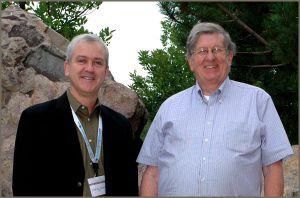
2013 Hanawalt Award – Dr. Robert Von Dreele
The International Centre for Diffraction Data is pleased to announce that Dr. Robert Von Dreele of the Advanced Photon Source, Argonne National Laboratory, has been named the 2013 recipient of the J.D. Hanawalt Award for excellence in the field of X-ray powder diffraction. This award recognizes Dr. Von Dreele “For his insight, courage and creativity in bringing powder diffraction to the macromolecular community.” The Award was presented to Dr. Von Dreele on 7 August 2013, during the Plenary Session of the 62nd Annual Denver X-ray Conference, held in Westminster, Colorado. He also presented his Hanawalt Award Lecture at that session, entitled “Protein Polycrystallography.”
Dr. Von Dreele’s research focuses on the development of X-ray and neutron powder diffraction, and its application to a wide variety of scientific problems. He pioneered the General Structure Analysis System program suite for Rietveld analysis, a valuable method for structural analysis of nearly all classes of crystalline materials not available as single crystals. Currently, his work centers on further extensions of protein powder diffraction including investigation of crystal growth, phase transformations, radiation damage and exploring possible routes to de novoprotein structure determination from powder data.
Dr. Von Dreele began using the Rietveld method in 1972. He is the author or co-author of more than 150 scientific publications on crystal structure results and techniques, most involving Rietveld refinement. He authored a publication describing the first protein structure solved from powder diffraction data.
Prior to joining Argonne in April 2003, Dr. Von Dreele served as Professor of Chemistry at Arizona State University (1971-1987), and was a Staff Scientist at Los Alamos National Laboratory (1987-2003).
The J.D. Hanawalt Award is named for Professor J. Donald Hanawalt, whose pioneering work in the 1930s led to the development of the PDF database structure and search/match procedures still in use today. The award is presented every three years for an important, recent contribution to the field of powder diffraction.
We extend our sincere congratulations to Dr. Robert Von Dreele!
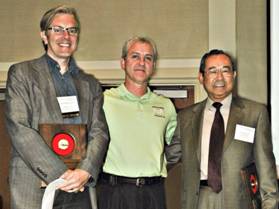
2010 Hanawalt Award – Dr. Simon Billinge
The International Centre for Diffraction Data takes pleasure in announcing that Dr. Takeshi Egami of the Joint Institute for Neutron Sciences, University of Tennessee, Knoxville, TN, and Oak Ridge National Laboratory, Oak Ridge, TN, and Dr. Simon J.L. Billinge of Applied Physics & Applied Mathematics, Columbia University, New York, NY were selected to receive the 2010 J.D. Hanawalt Award for excellence in the field of X-ray powder diffraction.
The presentation of the award took place at the 59th Annual Denver X-ray Conference, Denver, Colorado, USA, on 4 August 2010. The Award was established to recognize outstanding achievement in the XRD field within the last five years. Dr. Takeshi Egami and Dr. Simon Billinge were honored for their brilliant work in developing and extending the technique of Pair Distribution Function analysis of non-Bragg structures as exemplified in their book, “Underneath the Bragg Peaks”.
A special session entitled “Nanostructure Studies using the Atomic Pair Distribution Function” was held at the Denver X-ray Conference, where Drs. Egami and Billinge presented their Hanawalt Award lectures. Dr. Egami’s presentation focused on Recent Advances in the Pair Distribution Function Technique, while Dr. Billinge spoke on Structure at the Nanoscale: Atomic Pair Distribution Function Analysis of Nanostructured Materials.
Dr. Billinge received his B.A. in Materials Science at the University of Oxford in 1986, and Ph.D. in Materials Science and Engineering at the University of Pennsylvania in 1992. Dr. Billinge first worked at Michigan State University as an Assistant Professor of physics and astronomy, and by 2003 he worked his way up to the title of Professor. In 2008, Dr. Billinge arrived at Columbia University as a Professor, as well as a Senior Scientist at Brookhaven National Lab, Upton, NY. His research includes: nanoscale structure-property relationships in functional nanomaterials studied using novel X-ray and neutron scattering techniques coupled with advanced computing, as well as, solving the nanostructure problem.
Dr. Egami received his Bachelor’s degree in Applied Physics in 1968 at the University of Tokyo. In 1971, he received his Ph.D. in Materials Science from the University of Pennsylvania. Dr. Egami began teaching at the University of Pennsylvania in 1973 as an Assistant Professor. He became a Professor in 1980, and then Chair of the Materials Science and Engineering Department from 1997 to 2002. While teaching at Penn, Dr. Egami was Dr. Billinge’s thesis advisor in 1992. Dr. Egami is currently a Distinguished Professor at University of Tennessee, Knoxville and has written over 360 technical papers.
Congratulations to Dr. Takeshi Egami and Dr. Simon J.L. Billinge on receiving this prestigious award!

2010 Hanawalt Award – Takeshi Egami
The International Centre for Diffraction Data takes pleasure in announcing that Dr. Takeshi Egami of the Joint Institute for Neutron Sciences, University of Tennessee, Knoxville, TN, and Oak Ridge National Laboratory, Oak Ridge, TN, and Dr. Simon J.L. Billinge of Applied Physics & Applied Mathematics, Columbia University, New York, NY were selected to receive the 2010 J.D. Hanawalt Award for excellence in the field of X-ray powder diffraction.
The presentation of the award took place at the 59th Annual Denver X-ray Conference, Denver, Colorado, USA, on 4 August 2010. The Award was established to recognize outstanding achievement in the XRD field within the last five years. Dr. Takeshi Egami and Dr. Simon Billinge were honored for their brilliant work in developing and extending the technique of Pair Distribution Function analysis of non-Bragg structures as exemplified in their book, “Underneath the Bragg Peaks”.
A special session entitled “Nanostructure Studies using the Atomic Pair Distribution Function” was held at the Denver X-ray Conference, where Drs. Egami and Billinge presented their Hanawalt Award lectures. Dr. Egami’s presentation focused on Recent Advances in the Pair Distribution Function Technique, while Dr. Billinge spoke on Structure at the Nanoscale: Atomic Pair Distribution Function Analysis of Nanostructured Materials.
Dr. Billinge received his B.A. in Materials Science at the University of Oxford in 1986, and Ph.D. in Materials Science and Engineering at the University of Pennsylvania in 1992. Dr. Billinge first worked at Michigan State University as an Assistant Professor of physics and astronomy, and by 2003 he worked his way up to the title of Professor. In 2008, Dr. Billinge arrived at Columbia University as a Professor, as well as a Senior Scientist at Brookhaven National Lab, Upton, NY. His research includes: nanoscale structure-property relationships in functional nanomaterials studied using novel X-ray and neutron scattering techniques coupled with advanced computing, as well as, solving the nanostructure problem.
Dr. Egami received his Bachelor’s degree in Applied Physics in 1968 at the University of Tokyo. In 1971, he received his Ph.D. in Materials Science from the University of Pennsylvania. Dr. Egami began teaching at the University of Pennsylvania in 1973 as an Assistant Professor. He became a Professor in 1980, and then Chair of the Materials Science and Engineering Department from 1997 to 2002. While teaching at Penn, Dr. Egami was Dr. Billinge’s thesis advisor in 1992. Dr. Egami is currently a Distinguished Professor at University of Tennessee, Knoxville and has written over 360 technical papers.
Congratulations to Dr. Takeshi Egami and Dr. Simon J.L. Billinge on receiving this prestigious award!
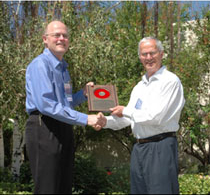
2007 Hanawalt Award – Dr. Tamás Ungár
The International Centre for Diffraction Data takes pleasure in announcing that Dr. Tamás Ungár of the Department of General Physics, Eötvös University Budapest, Hungary, was selected to receive the 2007 J.D. Hanawalt Award for excellence in the field of X-ray powder diffraction.
The presentation of the award took place at the 56th Annual Denver X-ray Conference, Colorado Springs, Colorado, USA, 1 August 2007. Dr. Ungár was recognized for his research interests on the dislocation model of strain anisotropy. The Hanawalt Award Lecture, which focused on this subject, was presented by Dr. Ungár in the Denver X-ray Conference Special Session on Stress Analysis.
Dr. Ungár’s research includes EXAFS; X-ray small-angle scattering on Al-base alloys; high resolution X-ray diffractometry, especially peak-profile-analysis; the real structure of metals and alloys; dislocation structure and densities; microdiffraction; particle size determination from X-ray diffraction; stored energy from dislocation density; microstructure; and crystallite size and size-distribution.
Dr. Ungár began his career as a teacher in the field of physics at Eötvös University Budapest in 1966. He has remained with the University over the length of his career and has taught courses in mechanics and thermodynamics, electricity and optics, solid state physics, diffraction physics, and materials science. He has authored more than 150 publications and his works have received over 1,600 independent citations.
- 2004 Hanawalt Award – Robert L. Snyder**
- 2001 Hanawalt Award – Raymond P. Goehner **
- 2001 Hanawalt Award – Joseph R. Michael
- 1998 Hanawalt Award – Herbert Göbel
- 1992 Hanawalt Award – Daniel Louër
- 1986 Hanawalt Award – William Parrish**
- 1983 Hanawalt Award – Ludo K. Frevel**
**Deceased
